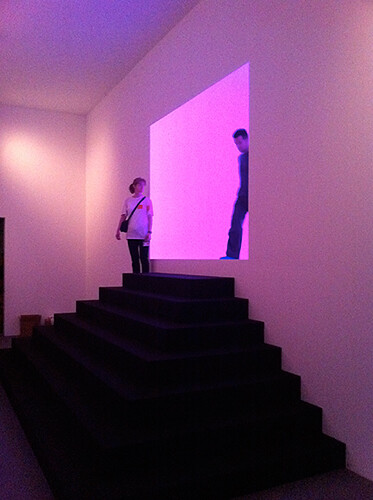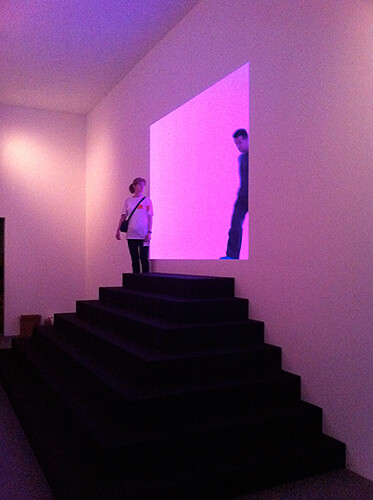June 4–November 27, 2011
Welcome to Biennale Nation. Like the city of Venice, it’s a bit hard to navigate with its quick twists and idiosyncratic logic; better find an insider or a tour. If you care for an adventure, use the title of the fair’s curated section as a compass: ILLUMInations.
At first reading, it seems that we might be in for a show on the artistic play of light and shadow. And as promised, the exhibition is chock full of phenomenally accented works that wondrously joust with our sensorium; James Turrell’s astounding Ganzfeld APANI (2011), or the artist-duo DAS INSTITUT’s Blocked Radiants (for loana) (2011), and R.H. Quaytman’s suite of paintings I Modi, Chapter 22 (2011). And just as we begin to settle into this mode of inquiry, a blast of interference takes the compass needle for a huge spin, resettling to confront us with strangeness of its own format: ILLUMInations.
Normally the suffix –tion alerts the reader that some process has affected the host word it is tagged to, i.e., illumination is the condition of being lit. But at the Biennale, curator Bice Curiger instead turns a homophonic pun by tying –nations to nations, as in states, in the exhibition literature. Considering the context of the rest of the fair, where individual countries present selected artists from their own citizenry in discreet buildings, this highly forced word association makes some degree of sense. Possibly as a proscriptive to this segmentation, the curator attempted to breakdown some of these divisions by displacing parts of the show with artist-designed para-pavillions scattered throughout the Arsenale and Giardini (i.e., amongst the national pavilions). More in this line, an architectural intervention by Monika Sosnowska cut-up one of the galleries in the Central Pavilion to form an irregular set of compartments hosting other artist’s installations. Still wishing to beat this literary framing device further, –nations was then conflated to mean border in the broadest sense, so that divisions of identity, discipline, history, etc. were also eschewed in favor of some vague wanderings on the porosity of artistic transference—be it reference, affinity, inspiration, or what have you. With this move, we come to the much ballyhooed section of the exhibition: the curator’s decision to present not only contemporary art in the lose folksonomy of the Biennale, but to include the Baroque master Tintoretto.
Holding pride of place in the most central core of the Central Pavilion are Tintoretto’s The Last Supper (1592–1594), The Stealing of the Body of St. Mark (1562–1566), and The Creation of the Animals, (ca. 1550). Why they were there, exactly, is a bit hard to ascertain, especially since all three of these paintings have been on view to the public in Venice for some time now. Maybe therein lies a clue?
On a pragmatic level, transporting these masterpieces was probably not as difficult, as, say, asking for a loan from the Louvre or Prado—and if so, a concealed underbelly to the show’s idea of “borders” is very much in effect. Conceptually, the re-contextualizing of the work might mitigate a perceived divide or secondary border between Biennale tourists who come for contemporary art, and the more “general” tourist who just wants to get their picture taken in front of San Marco Basilica. However, asserting such a divide is condescending.
In any case, Tintoretto is an artist noted for dynamic gradients; note the grisaille cloud of smoke and saints whirling about the lamps in the Last Supper. One could advance Tintoretto to the symbolic beacon of the exhibition’s interest in the use of light, particularly translucency, in art, while downplaying the artist’s radical use of highly exaggerated and dramatic perspectives (note the coconut shaped head of the woman on the ground in St. Mark). In addition, the ahistorical juxtaposition of trusting the work in the center of a contemporary exhibition could blur some notion of antiquarian historicism—which is perhaps also a “border”?
In some ways, this did happen, in particular in Shahryar Nashat’s ethereal and humorous film, Factor Green (2011), in which a day-glow plinth miraculously levitates and is drawn to the body of Tintoretto’s Saint Mark through the use of “movie magic”—reminding us that painting was in many ways the first form of virtual reality. Yet, these cross-pollinations become even more laughable and glib in the exhibition ephemera as the curator rambles, in one of many examples, that the Tintoretto works somehow have a relation to Urs Fischer’s Untitled (2011), in which a giant modeled souvenir candle of Giambologna’s Rape of the Sabine Women (1574–82), is melted away because they both share some connection to “art history”, or likewise, that Turell’s sci-fi light “echoes” Tintoretto’s palette.
History aside, these works do share a kind of loadstone quality as the Fischer holds down the heart of the Arsenale with its size and attendant crowds much in the same way the Tintoretto works anchor the Central Pavilion—Untitled is joined by two other works by Fischer as well. And like the Tintoretto pieces, the Fischer trio can be used as a lens to focus a view of its section; instead of being a mirror of luminosity, the Fischer and its paired tempo of the Arsenale is one of quick gloss as visitors glide seamlessly by the more commercial friendly and easy-to-digest galleries there. Unintentionally, the unchallenging quality of this zone is more like the frictionless interaction between an egg and a Teflon pan, rather than any sustained mediation of boarders and barriers. As such, it would be best to look elsewhere to pick up the trail of that argument again.
Previous to the opening, the curator circulated a questionnaire to all of the Biennale artists—not only from her curated section, but the artists in the national pavilions as well. This request asserted a set of five questions “on themes of identity and belonging” such as “if art was a nation, what would be written as its constitution?” In the exhibition rhetoric, this too was intended to be yet another move to breakdown some of the barriers between the artists in the curated section and the national pavilions; however, its remote distribution to personal addresses does little to facilitate the coordinated meeting of people. An agenda which can be construed by this is that the curator was trying to lay out a grounding mythos of the artistic community as its own national body, or at least, that this exhibition featured membership in her own temporary nation and fan base. Well, if that is the case, what are its policies, its narratives, and who are their keepers?
While I doubt it was intended to set-up Tintoretto as a founding father, the entourage of actual armed police guarding the most famous Art in the exhibition, in the most privileged court no less, does present some dark shades of patrimony. To undercut this a tad, and to the curator’s credit, Bruno Jakob’s joylessly slight Invisible Painting (2010–11), shared the room—which also provoked a fanatic side effect; the security detail did not allow the Tintoretto works to be photographed for whatever reasons, but they also extended this unique prohibition to the work of Jakob.
These very real barriers to the curator’s call for accessibility and transit did rear their head in other places as well, as liability claims prevented visitors from climbing Monica Bonvicini’s set piece of stepped platform stages in the Arsenale for example—thus producing another emblematic oil-like glide through that section—while the exhibition circulation around the Tintoretto security included non-reentry points blocked by tensabarriers and manned by more guards—causing much agitation by turned away guests. Like the chance performance enacted by the cops, the largest incidental visual message was found not on the Biennale’s grounds, but just outside. This, more vulgar display of power featured a giant security fence and guard booth around the moored yacht of Roman Abramovich, which took up more than half of the public sidewalk around the ship. Although a very troubling example of the privatization of public space—the berth and perimeter is also used for commercial cruise ships—the exhibition should have taken note of the boldness and antagonism of this gesture and figured out a way to hone its own message further through some assertion of a genuine, or more legible position. A contemporary artwork, which should have received more attention and care than the well-respected and secure old master, sent out useful signals in this regard.
Within the context of the show’s half-formed pairing of light, or let’s say, vision & power, Amalia Pica’s Venn Diagram (Under the spotlight) (2011), is the only work that truly brought notoriety to this coupling, while also touching on ideas of togetherness, socio-political history and the like. Here two lights, each with their own colored gels, shot two beams onto a wall in the Central Pavilion. Phased on and off, like a slow police emergency light, and activated by a motion sensor detecting the movement of trespassing passersby, one beam produced a red circle of light on the wall, and the other a blue light completed by a slight overlap between the two. Underneath these blinkers was a handwritten wall caption on an irrational prohibition by the dictatorship of Argentina in the 1970s. This censorship banned Venn diagrams, like the one formed by the light projection above, due to the subversive implications of these models of heterogeneity. As such, these fundamental pedagogical devices were removed from primary school textbooks and overt public usage. Pica’s piece not only brought to light the bizarre nature of this mandate, as well as revealing a ruling party’s inherent fear of the actual potential for power found when two or more groups make contact, the work’s understanding of light characteristics also produced a many-layered synthesis. Blended in the center of the red and blue surveying alarms was a bright, clear spotlight, which pointed to a need to watch all political and nationalistic colorings.













